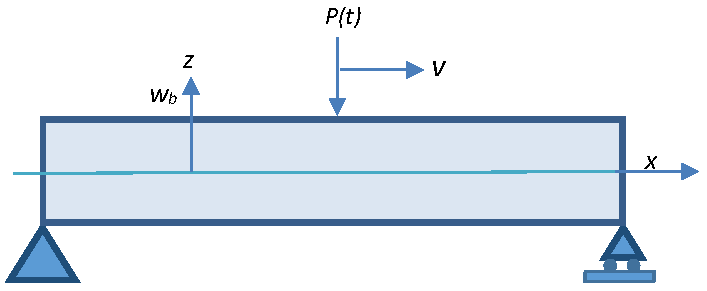A novel damage index extracted from frequency response of cracked Timoshenko beam subjected to moving harmonic load
Author affiliations
DOI:
https://doi.org/10.15625/0866-7136/17546Keywords:
cracked beams, moving load, frequency response, damage indexAbstract
In this paper, there is proposed a novel damage index extracted from frequency response of cracked Timoshenko beam under moving harmonic load using the so-called Modal Assurance Criterion (MAC) concept. First, frequency response of a cracked Timoshenko beam subjected to harmonic force moving on the beam with constant speed is obtained in an analytical expression. Then, a scalar characteristic like the coherence between the frequency responses of intact and cracked beams is determined and called herein Spectral Assurance Criterion (SAC). Such designed criterion is dependent upon crack parameters (location and depth), the load frequency and speed as well as position on beam where the responses have been measured. Numerical analysis shows that SAC is much more sensitive to crack than natural frequencies and can be used as a novel damage index for crack detection in beam using moving load. The effect of moving load frequency and speed has been also examined with the aim to have got an indicator most adequate for the crack detection problem.
Downloads
References
S. W. Doebling, C. R. Farrar, M. B. Prime, and D. W. Shevitz. Damage identification and health monitoring of structural and mechanical systems from changes in their vibration characteristics: A literature review. Los Alamos National Laboratory, USA, (1996), pp. 1–136.
H. Sohn, C. R. Farrar, F. M. Hemez, D. D. Shunk, D. W. Stinemates, B. R. Nadler, and J. J. Czarnecki. A review of structural health monitoring literature: 1996–2001. Los Alamos National Laboratory, USA, 1, (2003).
W. Fan and P. Qiao. Vibration-based damage identification methods: A review and comparative study. Structural Health Monitoring, 10, (2010), pp. 83–111.
R. Hou and Y. Xia. Review on the new development of vibration-based damage identification for civil engineering structures: 2010–2019. Journal of Sound and Vibration, 491, (2021),
X. Zhu, M. Cao,W. Ostachowicz, andW. Xu. Damage identification in bridges by processing dynamic responses to moving loads: Features and evaluation. Sensors, 19, (2019), p. 463.
H. Chouiyakh, L. Azrar, K. Alnefaie, and O. Akourri. Vibration and multi-crack identification of Timoshenko beams under moving mass using the differential quadrature method. International Journal of Mechanical Sciences, 120, (2017), pp. 1–11.
A. Khorram, F. Bakhtiari-Nejad, and M. Rezaeian. Comparison studies between two wavelet based crack detection methods of a beam subjected to a moving load. International Journal of Engineering Science, 51, (2012), pp. 204–215.
W.-Y. He and S. Zhu. Moving load-induced response of damaged beam and its application in damage localization. Journal of Vibration and Control, 22, (2016), pp. 3601–3617.
N. T. Khiem and P. T. Hang. Analysis and identification of multiple-cracked beam subjected to moving harmonic load. Journal of Vibration and Control, 24, (2017), pp. 2782–2801.
N. T. Khiem and P. T. Hang. Frequency response of a beam-like structure to moving harmonic forces. Vietnam Journal of Mechanics, 38, (2016), pp. 223–238.
R. J. Allemang. The modal assurance criterion–twenty years of use and abuse. Sound and Vibration, 37, (8), (2003), pp. 14–23.
N. A. J. Lieven and D. J. Ewins. Spatial correlation of modespaces: the coordinate modal assurance criterion (COMAC). In Proceedings of the 6th International Modal Analysis Conference, Kissimmee, Florida, USA, (1988), pp. 1063–1070.
A. C. Altunıs.ık, F. Y. Okur, and V. Kahya. Automated model updating of multiple cracked cantilever beams for damage detection. Journal of Constructional Steel Research, 138, (2017), pp. 499–512.
J. H. Kim, H. S. Jeon, and C.W. Lee. Application of the modal assurance criteria for detecting and locating structural faults. In Proceedings of the 10th International Modal Analysis Conference, San Diego, CA, USA, (1992), pp. 536–540.
A. Messina, E. J. Williams, and T. Contursi. Structural damage detection by a sensitivity and statistical-based method. Journal of Sound and Vibration, 216, (1998), pp. 791–808.
E. J. Williams and A. Messina. Applications of the multiple damage location assurance criterion. Key Engineering Materials, 167-168, (1999), pp. 256–264.
L. Balsamo, S. Mukhopadhyay, R. Betti, and H. Lus. Damage detection using flexibility proportional coordinate modal assurance criterion. In Topics in Modal Analysis, Springer New York, Vol. 7, (2013), pp. 1–8.
W. Heylen and S. Lammens. FRAC: A consistent way of comparing frequency response functions. In Proceedings of the International Conference on Identification in Engineering, Swansea,(1996), pp. 48–57.
R. Pascual, J.-C. Golinval, and M. Razeto. A frequency domain correlation technique for model correlation and updating. In Proceedings of the 15th International Modal Analysis Conference (IMAC XV), Orlando, USA, (1997), pp. 587–592.
D. Fotsch and D. J. Ewins. Application of MAC in the frequency domain. CiteSeerX, The College of Information Sciences and Technology, The Pennsylvania State University, (2000).
R. P. C. Sampaio, N. M. M. Maia, and J. M. M. Silva. The frequency domain assurance criterion as a tool for damage detection. Key Engineering Materials, 245-246, (2003), pp. 69–76.
N. T. Khiem and D. T. Hung. A closed-form solution for free vibration of multiple cracked Timoshenko beam and application. Vietnam Journal of Mechanics, 39, (2017), pp. 315–328.
T. G. Chondros, A. D. Dimarogonas, and J. Yao. A continuous cracked beam vibration theory. Journal of Sound and Vibration, 215, (1998), pp. 17–34.

Downloads
Published
How to Cite
License

This work is licensed under a Creative Commons Attribution-ShareAlike 4.0 International License.









